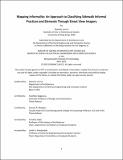| dc.description.abstract | By 2050, the United Nations estimates that 68 percent of the world’s population will live in cities, with 90 percent of that growth concentrated in rapidly urbanizing informal communities across Africa, Latin America, and Asia. In these contexts, informality, defined as unregulated commerce, adaptive reuse of space, incremental construction, and self-organized infrastructure, shapes the everyday choreography Jane Jacobs called the “sidewalk ballet.” Yet because governments rarely collect census-grade data on such activity, informality remains poorly documented and weakly understood. This thesis introduces a transferable computational framework to formalize informality by transforming street imagery into an auditable taxonomy of informal street-level elements, activities, and practices. The framework is tested in two contrasting districts, i.e. District 1 and District 5 of Ho Chi Minh City, where sidewalks are highly contested by vendors, pedestrians, and regulators. The contribution of this thesis is two-fold. First, this thesis contributes a three-stage pipeline for classifying sidewalk informality. Using Seesaw (Moll et al., 2022), a CLIP-based feedback loop retrieves and soft-labels candidate scenes. This is followed by manual verification and fine-tuning a lightweight ResNet on binary categories (e.g. stationary vs mobile vendors, etc.). Compared to the zero-shot model Qwen-VL-Max, the fine-tuned ResNet delivered more balanced performance (precision/recall: 0.62– 0.78) and better handled nuanced, context-sensitive distinctions. In contrast, Qwen-VL-Max favored recall and object salience but struggled with subtle or spatial cues like mobile vs. stationary setups. Second, this thesis also developed a taxonomy and annotated dataset of informality which was used to reveal spatial inequities in sidewalk use. By converting curbside complexity into structured, updateable categories, the framework enables planners to recognize the adaptive value of informal practices, target genuine hazards, and design interventions for more equitable urban planning. | |
